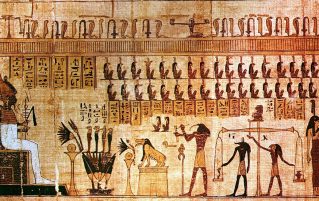

Sequences are everywhere, but before you revise the quadratic nth term, let us continue travelling through the history of maths.
Back in Ancient Egypt, around 1550 B.C, a scholar named Ahmose wrote the Rhind Papyrus. It is probably the first example of a maths textbook! At around 2 metres long, it contains 84 mathematical problems, including multiplication, fractions, division and geometry. About 100 years later, a man named Menna was in charge of field sizes, crop yields and calculating taxes. Wall paintings in his tomb demonstrate different techniques used for measuring and calculating these. The pictures show long distances being measured using ropes with knots tied into them.
Jumping forwards in time we start to recognise names, like the Ancient Greeks, Thales and Pythagoras! Thales (born 624 B.C.) was the first person to have a theorem named after him. We have all heard about Pythagoras and his theorem. However, did you know he founded a school in Italy, where mathematics was treated almost like religion. And, ahead of his time, women were accepted into the school!!
GCSE mathematicians – you need to be able to work with sequences. For help, try our new guide “How to work with Sequences: Part 2”. It includes information about quadratic sequences. In addition there are explanations of how to work out the nth term. As always there are questions to try, and answers to check your understanding.
Click on the picture below to see the guide.
If you found this useful and think you would benefit from some additional help, please contact us.
